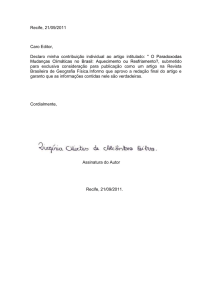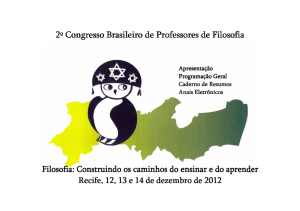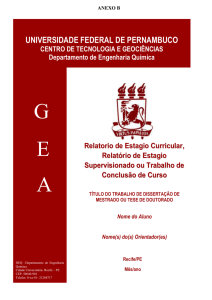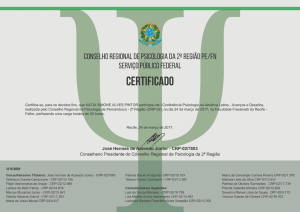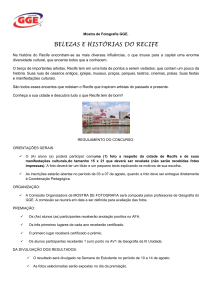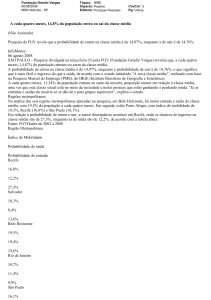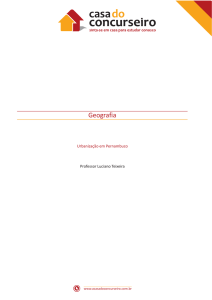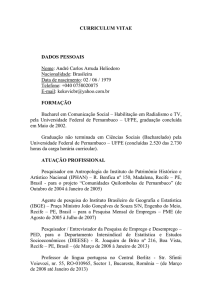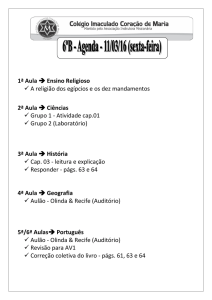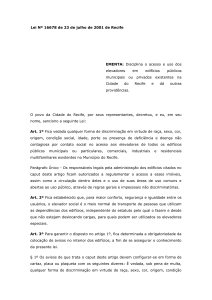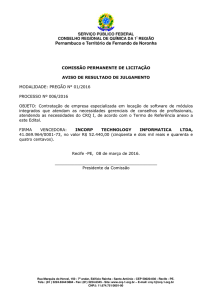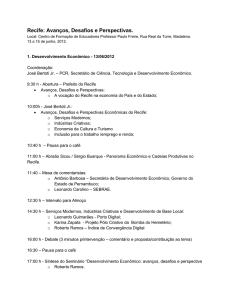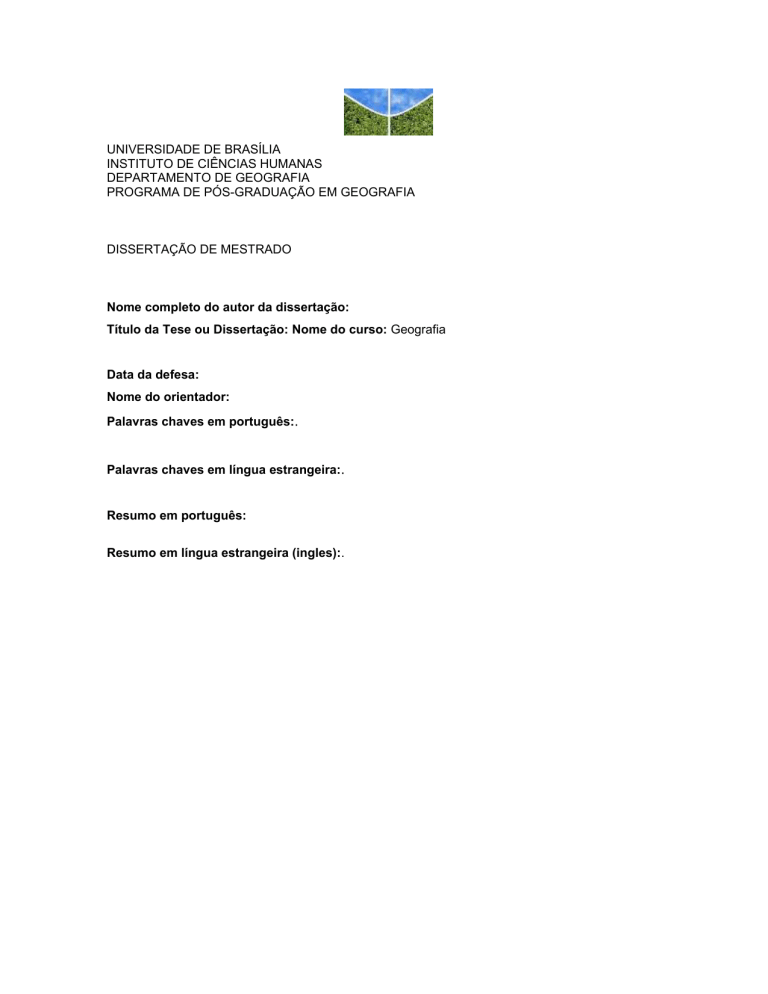
UNIVERSIDADE DE BRASÍLIA
INSTITUTO DE CIÊNCIAS HUMANAS
DEPARTAMENTO DE GEOGRAFIA
PROGRAMA DE PÓS-GRADUAÇÃO EM GEOGRAFIA
DISSERTAÇÃO DE MESTRADO
Nome completo do autor da dissertação:
Título da Tese ou Dissertação: Nome do curso: Geografia
Data da defesa:
Nome do orientador:
Palavras chaves em português:.
Palavras chaves em língua estrangeira:.
Resumo em português:
Resumo em língua estrangeira (ingles):.
EXEMPLO
UNIVERSIDADE DE BRASÍLIA
INSTITUTO DE CIÊNCIAS HUMANAS
DEPARTAMENTO DE GEOGRAFIA
PROGRAMA DE PÓS-GRADUAÇÃO EM GEOGRAFIA
DISSERTAÇÃO DE MESTRADO
Autor: Cleison Leite Ferreira
Título: O Espaço dos Maracatus-Nação de Pernambuco: Território e Representação
Nome do Curso: Mestrado em Geografia
Data da Defesa: 09/11/2012
Orientador: Prof. Dr. Rafael Sanzio Araújo dos Anjos
PALAVRAS-CHAVE: Maracatu-Nação, Territorialidade, Representação Cartográfica.
KEYWORDS: Maracatu-Nação, Territoriality, Cartographic Representation.
RESUMO
O Maracatu-Nação é uma importante manifestação cultural afro-brasileira presente no
estado de Pernambuco, mais especificamente na Região Metropolitana do Recife (RMR). É
caracterizado por um cortejo real formado por Reis e Rainhas negros, que saem nas ruas
acompanhados de membros da corte, de estandartes e de percussionistas que tocam e cantam
loas. Suas origens remetem as eleições e coroações de Reis e de Rainhas do Congo escolhidos
em irmandades leigas, que congregavam uma grande diversidade de grupos étnicos africanos
presentes no Recife entre os séculos XVI e XIX. Com o tempo, essas manifestações foram sendo
reinventadas pela população de matriz africana e passaram a ser o que ficou denominado de
Maracatu-Nação. Os Maracatus-Nação cresceram em quantidade de Nações e de adeptos
existindo, na RMR, no ano de 2012, vinte e sete Nações, e se tornaram símbolo da identidade
cultural pernambucana. Atualmente, os Maracatus-Nação estão vinculados às religiões
denominadas Xangô (ou Candomblé), Jurema Sagrada e Umbanda, definindo territorialidades
religiosas no cotidiano e nos dias de carnaval, principalmente no ritual Noite dos Tambores
Silenciosos que acontece, no centro do Recife, em homenagem aos ancestrais, denominados
Eguns. Suas práticas culturais, que envolvem um saber partilhado entre as gerações, criam um
sentimento de pertencimento e de afirmação de referências étnicas de origens africanas e definem
territorialidades que repercutem tanto nas periferias como na área central do Recife, tendo suas
sedes como as principais referências no território, por estarem inseridas em comunidades e
bairros, criando vínculos sociais e comunitários. O objetivo deste trabalho é identificar, registrar e
representar, por meio de registros cartográficos e fotográficos, o território e a territorialidade dos
Maracatus-Nação da Região Metropolitana do Recife, destacando suas práticas sociais e seus
aspectos identitários. Definiu-se como recorte espacial a Zona Norte do Recife, por concentrar a
maior quantidade de Nações e por suas proximidades com diversos terreiros de Xangô, entre eles
o Ilê Axé Obá Ogunté – Sítio do Pai Adão, o terreiro mais antigo do Recife. Foram realizadas
investigações de campo e utilizados recursos cartográficos e fotográficos como forma de registro
para a representação espacial e visual dos Maracatus-Nação e por serem instrumentos eficazes de
leitura e interpretação do território e permitirem compreender a historicidade e a dinâmica atual
dessas manifestações culturais. Concluiu-se basicamente que os Maracatus-Nação criam
territórios, sendo possível registrar, medir e representar cartograficamente suas territorialidades.
Nesse sentido, recomenda-se que seu espaço seja reconhecido pelo poder público por sua
potencialidade e possibilidade de exercício da cidadania e de vivência das referências étnicas da
população de matrizes africanas tantas vezes desconsideradas da totalidade do espaço
metropolitano do Recife.
ABSTRACT
The "Maracatu-Nação" is an important cultural expression originally from african-Brazilian the state
of Pernambuco, Brazil, specifically in the Metropolitan Region of Recife. It is characterized by a royal
procession consisting of black Kings and Queens, that walk on the streets followed by members of
the court, with banners and percussionists who play and sing praises. Its origins date back to the
elections and coronations of Kings and Queens chosen within the lay brotherhoods who
congregated a great diversity of African ethnic groups present in Recife between the sixteenth and
nineteenth centuries. Over time, these demonstrations were being reinvented by people of African
origin and became what was called Maracatu nation. The Maracatus-Nação grew in quantity of
Nations and number of adherents, existing in 2012 twenty-seven Nations, and became a symbol of
cultural identity Pernambuco. Currently, the Maracatus-Nação are linked to Xangô (Candomble),
Jurema and Umbanda religions, defining religious territorialities in daily life and in the days of
Carnival, especially in Night of the Silent Drums ritual that happens in homage to ancestors, called
Eguns. Their cultural practices that involve shared knowledge between generations, create a sense
of belonging and affirmation of ethnic references of African origins and define territoriality that
impact both in the suburbs and in the central area of the Metropolitan Region of Recife, having their
headquarters as main references in the territory, being inserted in communities and neighborhoods
by creating social bonds and community. The objective of this work is to investigate and represent
the territorial and cultural identity of African origin in Recife (PE) through "Maracatus-Nação",
highlighting their practices and their social identity aspects. It was defined the North Zone of Recife
as the spatial area, by concentrating the greatest amount of Nations and its vicinity with many
“terreiros of Xangô”, including Ile Axe Obá Ogunté – Terreiro do Pai Adão, the oldest terreiro of
Recife. We used photographic and cartographic resources as a way of visual and spatial
representation of "Maracatus-Nação" that besides being effective tools of reading and interpretation
of the territory allow us to understand the historical and current dynamics of cultural manifestations.
It was concluded that basically the Maracatus-Nação create territories and it is possible to record, to
measure, and to cartographically represent their territoriality. Accordingly, it is recommended that
their space be recognized by the government for its potentiality and possibility of citizenship and
experience of ethnic references of the population of African origin often disregarded the entire
metropolitan area of Recife.

